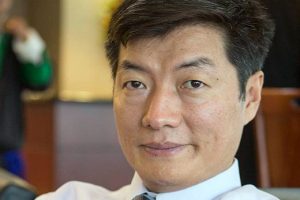
Guo Gu’s work with Shambhala Publications is a terrific service to the gradual growth of knowledge about Chan Buddhism. He has so far written several excellent books about this unique Chinese-grown expression of instant enlightenment, such as The Essence of Chan: A Guide to Life and Practice According to the Teachings of Bodhidharma (Shambhala 2020) and Silent Illumination: A Chan Buddhist Path to Natural Awakening (Shambhala 2021). His latest work, Silent Illumination, provides a poetic and fascinating articulation of a spiritual path that should otherwise be impossible to communicate in words or concepts. Enlightenment, as many Chan writers would say, is an experience found in practice and deep awakening. The specific practice propounded in this book is silent illumination. Its aims are: “First, to establish silent illumination squarely within the Mahayana Buddhist traditions. Second, to offer detailed instructions for establishing a foundation for realizing silent illumination. Third, to offer quality translations of Hongzhi’s poetic writings on silent illumination.” (viii)
Having studied under Master Sheng Yen (1931–2009), Guo Gu, otherwise known as Jimmy Yu, is the founder of the Tallahassee Chan Center and has written, taught, and conducted retreats about Chan extensively. He is knowledgeable about various Chan masters but is particularly inspired by Caodong luminary Hongzhi Zhengjue (1091–1157), who compiled a series of writings on the concept of silent illumination. He was also influential on the later Soto Zen school in Japan. Some of his writings form the third part of Silent Illumination, having been translated into English by Guo Gu. There are two preceding parts: “Silent Illumination,” which comprises the bulk of the book, and “Commentaries.” “Silent Illumination,” discusses the significance of this essential Chan teaching and cultivation of the right mindset with which to practice silent illumination. Part Two consists of Guo Gu’s commentaries on three of Hongzhi’s teachings, detailing pre- and post-awakening practices. These commentaries were originally given in evening talks in a series of intensive Chan retreats hosted by Guo Gu, and they discuss aspects of Chan practice, psychosomatic states or mental “scenery,” and the depth of initial awakening and post-awakening cultivation. Part Three showcases 25 translated excerpts of Hongzhi’s collected writings.
It is rare that Chinese Chan masters can be accessed in such easy and eloquent English, and Guo Gu’s book has a way of reassuring the reader that they are in familiar territory while pushing them slightly beyond to pose useful spiritual questions. The release of Silent Illumination also speaks well of Shambhala’s growing collection of updated works on Chinese Chan. The publishing house—in good part thanks to the late Thomas Cleary (1949–2021)—was ahead of its time in releasing works on Chinese spirituality, from the Dao De Jing to Chinese Buddhist texts, even while much of Western interest in East Asian Buddhism was focused on Japanese Zen. Thanks to Guo Gu and others, Shambhala’s contemporary library of accessible Chinese Buddhism for a Western audience is growing larger yet.
The title of the book is an acknowledgement of the futility of conceptual thought and the inherent flaws of spoken language. The first priority of Chan is to deconstruct premises and to radically dismantle our need for discursive thought in understanding the Dharma, which is beyond all language and words. Therefore, as the title indicates, illumination or enlightenment can be found only in the void of non-conceptuality, where concepts themselves are no longer reified into words and language, but returned to their non-dual source of no-mind harmony: “Silent illumination is a shared language for awakening that rests on a playful interdependence of opposites: wisdom and compassion, stillness and activity, quiescence and wakefulness, essence and function.” (7)
In an echo of apophatic or negative theology, Guo Gu writes that enlightenment is found in “the interplay of silence and illumination, quiescence and wakefulness, stillness and activity.” (8) Reality is found in that which is beyond thought itself, and in Part One Guo Gu lays out exactly how a Chan practitioner can touch that reality through seven chapters. The second part is intended as more advanced material for the reader after completion of Part One. Guo Gu points out that Hongzhi’s instructions are not always the easiest to understand. There are three main excerpts that Guo Gu examines: “The Vacant Field,” (85–96) “The Investigation,” (97–108) and “Multitasking.” (109–17)
Part Three, as mentioned above, is a compilation of translated passages building on the theme of silent illumination. Master Hongzhi’s poetic imagery is evident again, for example, the first excerpt chosen by Guo Gu—and also the focus of his first section in Part Two—invokes a “vacant and open field:
This field is where birth and death do not reach. It is the source of utter luminosity, able to emit light and respond clearly to the myriad dust motes [of sensory objects]. It is empty, without oppositions. The wondrous [activity] of seeing and hearing leaps far beyond those everyday sounds and forms. In all situations, its functioning is without trace; its mirroring is without obstruction. Mind and its objects naturally and spontaneously issue forth without partiality. (123)
Guo Gu’s instruction on the practice of silent illumination is comprehensive and beyond the scope of this review. However, Hongzhi himself said: “The correct way of practice is to simply sit in stillness and silently investigate; deep down one reaches a state where externally one is no longer swayed by causes and conditions. The mind being empty, it is all-embracing; its luminosity being wondrous, it is precisely apt and impartial.” (4) Guo Gu shortly afterwards writes:
The spaciousness or emptiness of the room is the ‘silence’ in silent illumination. The ability of the room to accommodate all sorts of furniture is the ‘illumination’ of silent illumination. Our true mind has no delineating borders, and it has infinite potential; we have the ability to respond to the needs of all beings creatively, immeasurably. Just as space is not the result of our moving the furniture around the room, awakening is not something that we gain from our efforts in ‘practice.’ Yet, by working with the furniture—fixing the dilapidated pieces, recycling the old ones, and clearing up the clutter—it’s more likely that we’ll recognize the spaciousness of the room. (5)
There is much more to be said about the actual practice and realization of this insight into reality, but chapters 2–7 in Part One outline in considerable depth, based on Guo Gu’s teaching experience, how one can approach the practice. Of particular interest is Chapter Six, in which silent illumination is outlined and explained in four unique ways: embodied experiencing, direct contemplation, contemplating space, and shamata and vipashyana.
Guo Gu has written an excellent book that, despite the inherent futility of words, does an excellent job in articulating the Caodong Chan experience as expounded by Hongzhi to an English-reading audience. While some might feel that there could be something lost in the translation of Chan texts, perhaps the emphasis on linguistic futility—itself a pedagogical tool in Chan—can actually work as an argument for the universality of communicating the no-mind Dharma. If all language is futile, and all languages are ultimately fingers pointing at the Moon, then pure silence is far more essential than any language when all things are said and done. Far more important is how we engage with silent illumination. We must discover which path of approach is right for us personally.
Reference
Guo Gu. 2021. Silent Illumination: A Chan Buddhist Path to Natural Awakening. Boulder, CO: Shambhala Publications.
See more
Pointing to the Heart of the Buddhadharma: An Interview with Guo Gu, author of The Essence of Chan (Shambhala)
Related news reports from Buddhistdoor Global
Prolific Translator of Buddhist Texts Thomas Cleary Dies Aged 72
Related features from Buddhistdoor Global












